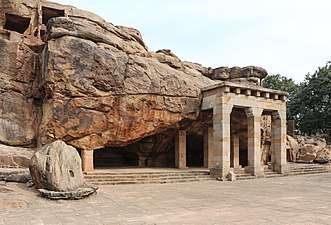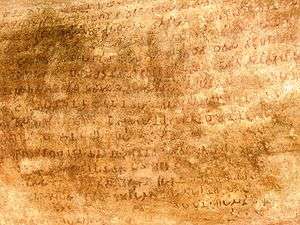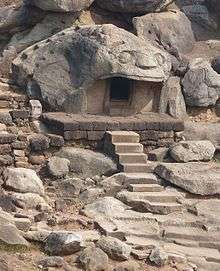Mahameghavahana dynasty
| Maha-Meghavahana Dynasty Mahāmēghabāhana | |||||||||
|---|---|---|---|---|---|---|---|---|---|
| c. 250s BC–c. 5th century CE | |||||||||
| Religion | Jainism | ||||||||
| Government | Monarchy | ||||||||
| Historical era | Classical India | ||||||||
• Established | c. 250s BC | ||||||||
• Disestablished | c. 5th century CE | ||||||||
| |||||||||
The Mahameghavahana dynasty (Mahā-Mēgha-Vāhana, c. 250s BC to 5th century CE) was an ancient ruling dynasty of Kalinga (modern-day Odisha state) after the decline of the Maurya Empire. The third ruler of the dynasty, Kharavela is known by his Hathigumpha inscription.
Kharavela patronised Jainism, but did not discriminate against other religions.[1][2]
Architecture
Udayagiri and Khandagiri Caves is the most prominent example of Mahameghavahana dynasty work. These caves were built in 2nd Century BCE during the rule of King Kharavela. Udayagiri means "Sunrise Hill" and has 18 caves while Khandagiri has 15 caves. The Hathigumpha cave ("Elephant Cave") has the Hathigumpha inscription, written by Raja Kharavela, the king of Kalinga in India, during the 2nd century BCE. The Hathigumpha inscription consists of seventeen lines incised in deep cut Brahmi letters starting with Jain Namokar Mantra. In Udayagiri, Hathigumpha (cave 14) and Ganeshagumpha (cave 10) are especially well known due to art treasures of their sculptures and reliefs as well as due to their historical importance. Rani ka Naur (Queen's Palace cave, cave 1) is also an extensively carved cave and elaborately embellished with sculptural friezes. Khandagiri offers a fine view back over Bhubaneswar from its summit. The Ananta cave (cave 3) depicts carved figures of women, elephants, athletes, and geese carrying flowers.
 Udayagiri
Udayagiri Ganesha Gumpha (cave no-10), Udayagiri
Ganesha Gumpha (cave no-10), Udayagiri Hathi Gumpha (cave no-14), Udayagiri
Hathi Gumpha (cave no-14), Udayagiri
 Carving of Tirthankaras & Goddesses inside Navamuni Gumpha
Carving of Tirthankaras & Goddesses inside Navamuni Gumpha- Cave monastery in Khandagiri
 Carving of Jain Tirthanakars
Carving of Jain Tirthanakars Sarpa Gumpha (cave no-13), Udayagiri
Sarpa Gumpha (cave no-13), Udayagiri
References
- ↑ Hampa Nagarajaiah (1999). A History of the Early Ganga Monarchy and Jainism. Ankita Pustaka. p. 10. ISBN 978-81-87321-16-3.
- ↑ Kailash Chand Jain (2010). History of Jainism. D. K. Print World (P) Limited. p. 437. ISBN 978-81-246-0547-9.
External links